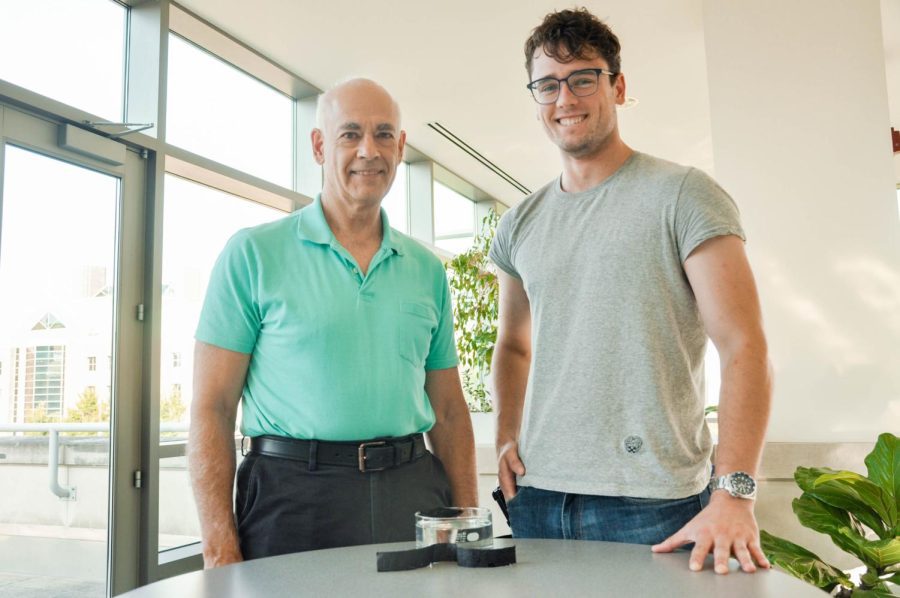Illinois researchers improve production of carbon nanotubes
Joseph Lyding, professor in Engineering, and Branden Wolan, graduate student studying electrical and computer engineering, pose with the 3D printed carbon nanotube film in the Nick Holonyak Micro and Nanotechnology Laboratory on Friday.
September 16, 2022
At the University of Illinois, researchers have been developing carbon nanotubes — manufacturable, adaptive material with many applicable uses. They are only one-to-two nanometers in size but have great tensile strength, great thermal conductivity, strong electromagnetic interference shielding performance, solid water-repellant properties and established multi-functionality.
The issue is that these properties aren’t available in bulk and used to be expensive. However, the Lyding Group has found that there are ways to circumvent these issues.
When trying to make the nanotubes stick together while retaining the properties of an individual tube, the Lyding Group found that if they mixed nanotubes with a different polymeric material — a cold blend of nanotubes plus polymer — the exquisite properties were watered down. The group’s study found a way to make pure, straight carbon nanotubes without the polymer, which resulted in a dramatic enhancement of these properties.
“By eliminating the use of a polymeric tightening agent to hold the nanotubes together, we get closer to the intrinsic properties that carbon nanotubes have,” said Joseph W. Lyding, professor in Engineering and leader of Lyding Group. “We still have a ways to go, but we made a big step in improving the properties.”

(Sydney Laput)
He detailed another development that improves the carbon nanotubes further. “We have an agent that allows the carbon nanotubes to be converted into an ink that we can 3D print,” Lyding said. “We can get rid of (the agent) completely after the printing, so we are just left with pure carbon nanotubes.”
Get The Daily Illini in your inbox!
Brendan Wolan, a graduate student studying electrical and computer engineering and co-author of the Lyding Group study, mentioned that in the paper, they were able to demonstrate a way that they could give a significant amount of direction to these tubes without much effort.
“It’s really tricky to find ways to manipulate countless amounts of these particles in a really consistent manner,” Wolan said. “And so what we did in the paper is we disperse it back into a solution.” Wolan noted that this is done by injecting the carbon nanotubes into a coagulation bath through a long syringe needle.
According to Wolan, because the tubes are very long but very skinny, there is a fluidic force exerted upon them. That makes them all want to line up within the syringe because it’s going to lower the resistance to the flow. With all the carbon nanotubes lined up in the syringe, they eventually lie down and align with the direction of printing.
Wolan explained that with the 3D printer, one could program it to do whatever shape they want, which includes the film associated with the carbon nanotubes. According to Wolan, this method allows for “radical improvements in terms of tensile strength, electrical conductivity and thermal conductivity.”
This development makes the thermal conductivity of the carbon nanotubes better than that of copper, while the nanotubes themselves weigh less than copper as well. Wolan noted that these characteristics make the single-walled carbon nanotubes promising for industries such as aerospace.
According to Lyding, this material has many general applications as well. Lyding explained that the material is very good at electromagnetic shielding, so if one wanted shielding and a phone immune to electromagnetic interference, they would be able to use this material, as it is quite thin and light. In addition, carbon nanotubes are already being used in high-end sports such as skiing, golf and tennis.
From an electronics standpoint, Lyding noted that many companies want to be able to make transistors — electric components used in electrical circuits to either amplify or switch electrical signals or power — smaller.

(Sydney Laput)
However, once individuals try to go smaller, they enter the quantum world, which opens up more issues such as a quantum tunnel, which contains a leakage current between two metal transistor electrodes. The leakage happens when the gap between the electrodes narrows to the point that electrons are no longer contained by their barriers.
The value of a transistor is whether an individual knows if it is on or off and because carbon nanotubes have a directional orientation, they help in answering that issue.
Regarding the future of carbon nanotubes, there is a lot left in terms of improving the properties of these materials. For example, connecting pieces of metal together often involves welding or soldering, but that isn’t possible with carbon nanotubes. However, there has been progress. Brendan Wolan was able to set up this process of 3D printing carbon nanotubes in a facility at Northrop Grumman in summer of 2021.
In addition, undergraduate students have been allowed access to this technology in classes such as ECE 481: Nanotechnology and ECE 518: Advanced Semiconductor Nanotechnology. Lyding said that in these classes, they aim to not repeat the same experiment but instead explore other experiments with the material, allowing for further insights into the technology.
According to Wolan, Beckman has done a great job in allowing opportunities such as the carbon nanotubes study to be researched further. “Beckman and the (College of Engineering) do a really great job of centralizing all this expensive technology that so many people are using, and you have access to these experts in their field regarding these instruments,” Wolan said.
Lyding echoed the points that Wolan said regarding Beckman. “Interacting with people at Beckman and all these people wandering around the building and talking to each other in an informal sense leads to people starting to work together and realizing they can help each other out,” Lyding said. “Having all those perspectives in one place under one roof makes a huge difference, and that’s what Beckman is all about.”







